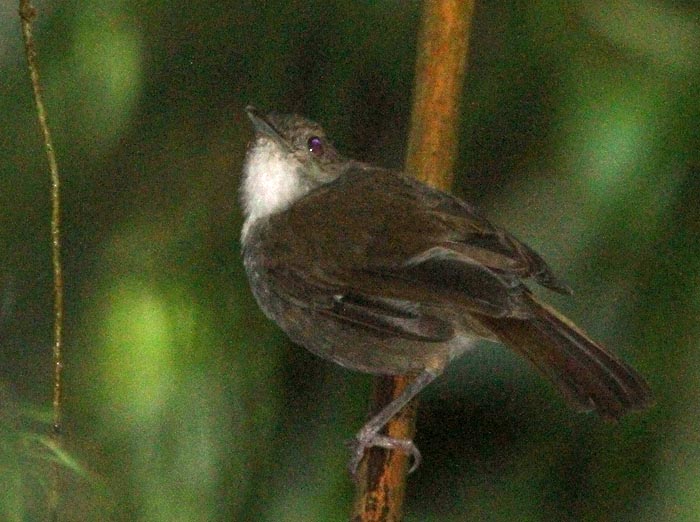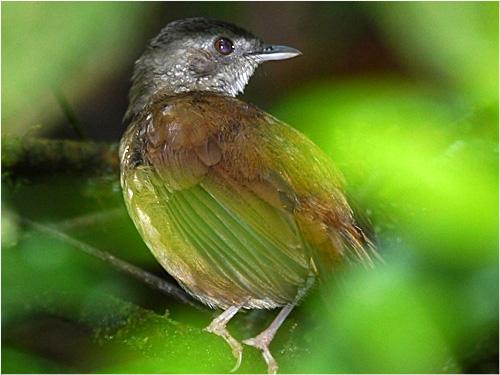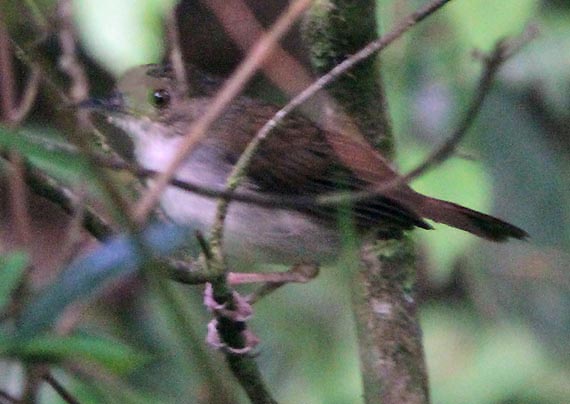
a web page by Don Roberson |
GROUND-BABBLERS & ALLIES Pellorneidae |
|
Some of these ground-babblers are called wren-babblers, such as the Mountain Wren-Babbler (left in a fine shot by James Eaton), an endemic to the high mountains of northern Borneo. |
Most wren-babblers are ground-loving species, elusive and difficult to observe in the forest understory, and best found by their vocalizations. These are quite small, chubby, long-legged birds with various patterns of spots or streaks in brown, blackish, or rufescent plumage — Asia's version of gnateaters. Not all "wren-babblers," though, are classified in this family. One big surprise in Gelang et al. (2009) was that one of a half-dozen genera of wren-babblers — the four species in genus Pnoepygidae — were not within any babbler lineage. They recommended a new family, the Pnoepygidae, for those tiny, short-tailed, "wren-babblers." These are now known as Cupwings. The remaining genera termed wren-babblers (e.g., Rimator, Ptiolcichla, Kenopia, Napothera) are babblers, and most are now assigned to this family [Pellorneidae] but not those is genus Spelaeornis, which are now in the Timaliidae family. This means that the term "wren-babbler" is a generic term, no longer defined by classification. Yet the wren-babblers include some of the most difficult birds to see on earth, almost any one of which is the highlight of any day's birding. Some are quite specialized (limestone hills, swamps, bamboo, humid fern forest) and a fair number are rare and local; others are endemic to Borneo, or the Philippines, or Sumatra. It took me days and the help of a great local guide to see Bornean Wren-Babbler Ptiolcichla leucogrammica and Black-throated Wren-Babbler Turdinus atrigularis in Danum Valley, Sabah, Borneo. Striated Wren-Babbler Ptiolcichla mindanensis and Falcated Wren-Babbler P. falcata are two of the difficult but dramatic birds to find in the Philippines. |
While Asia is the center of babbler diversity, a number of African species are assigned to the Pellorneidae. Among African babblers are the drab but beautifully vocal illadopsis (7 species in the namesake genus Illadopsis) which in many ways recall some of the plainer Alcippe fulvettas of Asia. An example is Scaly-breasted Illadopsis of central Africa (left, nice photo by Nik Borrow). Illadopsises are among the best songsters in jungles anywhere, but so difficult to spot (let along photograph!). |
As to other mysterious wraiths, I previously wrote that "Bagobo Babbler Leonardina woodi and Rusty-faced Babbler Robsonius rabori (formerly "Rabor's Wren-babbler"), both Philippine endemics, have weak, almost inaudible, songs and are pretty much 'impossible' to see." As it turns out, Leonardina and Robsonius are unlike other babblers because they aren't babblers! Genetic research (Moyle et al. 2012) showed they were not within the babbler assemblage at all — Leonardina is now in the Muscicapidae and Robsonius in the Locustellidae |
Photos: James Eaton photographed the Mountain Wren-Babbler Napothera crassa on Mt. Kinabalu, Malaysian Borneo, in June 2002. The Sulawesi Babbler Pellorneum celebense was at Gunung Ambag, Sulawesi, on 5 Oct 2011. Nik Borrow photographed the Scaly-breasted Illadopsis Illadopsis albipectus in Bwindi-Inpenetrable Forest NP, Uganda, on 23 Aug 2011. The White-chested Babbler Pellorneum rostratum was in the Panti Forest, Malaysia, on 24 Sep 2011. Ucredited photos © Don Roberson; credited photo attributed to James Eaton and Nik Borrow, as credited and used with permission here); all rights reserved. Nik Borrow has a great website filled with photos, videos, art, and his adventurous life as a professional bird guide and field guide author. Bibliographic notes There is no recent "family book" covering the tree-babblers but good coverage of the various babbler families, including the current Pellorneidae, is in Collar & Robson (2007). The account is wonderful, with exceptional photos, although it could not be quite up-to-date with the most current taxonomic findings., some of which post-date its publication. Literature cited:
|
 Genetic
evidence has broken-up and then reconstructed the Babblers. Recent
papers (Gelang et al. 2009, Cibois et al. 2010, Moyle et al. 2012) have
left us with an understanding that there are three major clades within
the "core babblers." Most consider these clades to be Families (e.g.,
Fregin et al. 2012) and I do so here. One of these new families is the
Pellorneidae, which combines a revised fulvetta grouping with many of
the Old World ground-babblers. Together there are about 58 species in
13 genera (Gelang et al. 2009, as further revised by Moyle et al. 2012).
Genetic
evidence has broken-up and then reconstructed the Babblers. Recent
papers (Gelang et al. 2009, Cibois et al. 2010, Moyle et al. 2012) have
left us with an understanding that there are three major clades within
the "core babblers." Most consider these clades to be Families (e.g.,
Fregin et al. 2012) and I do so here. One of these new families is the
Pellorneidae, which combines a revised fulvetta grouping with many of
the Old World ground-babblers. Together there are about 58 species in
13 genera (Gelang et al. 2009, as further revised by Moyle et al. 2012). There
have been many generic revisions among those birds that remain within
the babbler assemblage as the result of recent molecular evidence about
evolutionary relationships (e.g., Moyle et al. 2012). At one time, for
example, there were 17 species of Alcippe fulvettas. Now, seven are assigned to genus Schoeniparus and belong to this family; the rest remain in Alcippe
but are now considered to be among the Laughingthrush subfamily
[Leiothrichidae]. Further adjustments have taken place among the Malacocincla babblers (now just 3 species) but an enlarged 13 species in genus Pellorneum (three previous 'Trichastoma' babblers are merged into Pellorneum). These latter species are widespread in southeast Asia, and include Sulawesi Babbler (right), found all the way east —and over Wallace's Line —in Sulawesi.
There
have been many generic revisions among those birds that remain within
the babbler assemblage as the result of recent molecular evidence about
evolutionary relationships (e.g., Moyle et al. 2012). At one time, for
example, there were 17 species of Alcippe fulvettas. Now, seven are assigned to genus Schoeniparus and belong to this family; the rest remain in Alcippe
but are now considered to be among the Laughingthrush subfamily
[Leiothrichidae]. Further adjustments have taken place among the Malacocincla babblers (now just 3 species) but an enlarged 13 species in genus Pellorneum (three previous 'Trichastoma' babblers are merged into Pellorneum). These latter species are widespread in southeast Asia, and include Sulawesi Babbler (right), found all the way east —and over Wallace's Line —in Sulawesi. 
 Many of these difficult ground-babblers are best located by voice. Just one example is White-chested Babbler (right) of southeast Asia and Greater Sundas.
Many of these difficult ground-babblers are best located by voice. Just one example is White-chested Babbler (right) of southeast Asia and Greater Sundas.